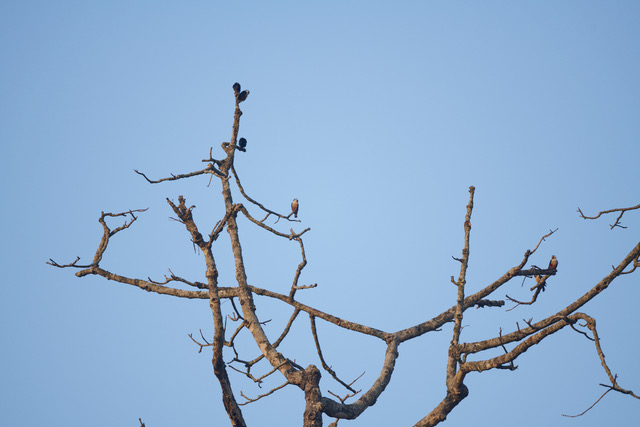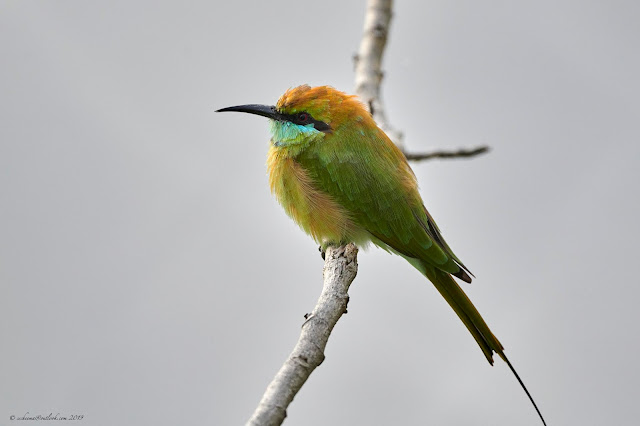Well, Honeyguides are an interesting birds and there are a number of them. Ten to be precise in the Genus Indicator. Eight of them found in Africa and two in Asia. Out of these two - one in India. I was chasing the one in India, the Yellow-rumped Honeyguide. I will get on to it after telling this story to start with. The story goes that I wanted to see this bird (like all other birds of the world I must add) and set my mind to it. Now every time I visited the Himalayas, I was on a constant lookout - I was waiting for and encounter in Sikkim, Arunachal Pradesh, Nagaland and of course on my last visit to Uttrakhand. Well to be fair I was also looking out for it in our visit to Borneo, the other Honeyguide of Asia - Malaysian Honeyguide. Well, being on a lookout and to actually see the bird is like the sip and the lip - both close but it will be when it will be.
 |
| The hunting party - our Birdguide on the left... |
 |
| The Yellow rump being clearly displayed. |
 |
| The bird that refused to be afraid - leading me to the Beehive? |
My visits to Sikkim, Nagaland, Arunachal Pradesh and even Borneo were a washout and this happened over a period of more than 5 years. Then came the last birding trip to Uttrakhand, a trip to Chopta, tugged in-between the two COVID lockdowns, that still had the name of this bird as a target species along with a dozen others I must say. Our Birdguide was absolutely certain that we will see the bird and in hearts of hearts, I was not so sure. The past failures were weighing heavy on my mind to say the least. Well the day arrived and we walked upstream from the road the first day at Chopta and that was where we were to see the bird for sure, or so our Birdguide has said - like a 100% sure. Well we waited, scanned the area for any signs at all for the birds - but for the huge Beehives humming with bees in the far distance on a ledge - there was nothing. Well they were other birds and pretty ones - but this was not to be. We waited and scanned the nearby areas for over an hour. Since we were to reach our destination that was still a few hours away we had no choice to cut the chase and after a small Maggie Lunch and moved on. The disappointment was on my face. A few hours down the lane we stopped again with a Cliff in far distance and the Birdguide telling us that we might be lucky here as the bird is seen at this place also sometimes. Missing the bird where it was surely to be seen and now at a place where it is sighted sometimes is really not very hopeful. Well, we stopped at the stream and all our group started looking out for some beautiful birds around the stream. I asked our guide if we can walk along the road to the place near the Beehives that was about half a km away and since rest did not respond enthusiastically - we both, the Birdguide and me, moved on. As luck would have it, just about 200 m ahead - there was a flutter in a tree nearby and both the Birdguide and me shouted simultaneously - HoneyGuide. I was shaking with excitement and moving my feet barely a few inches at a time to ensure the bird does not fly away. The bird was still not clearly visible even though we were hearing it and catching the glimpses of it in that tree. I got one clear shot and the bird decided to be more confident than me. It perched on to a branch an arms length away and was not at all afraid. I heart was jumping with joy - I called out to the rest of the team. The bird did not mind my shout at all - they all came - and the bird was there still singing in front of all of us and what a day we had.
 |
| Oh what a sight it was - especially when it has eluded you for 5 years plus some change ;-) |
The Scientific Name of the bird is Indicator xanthonotus. The first part of the name, Indicator, and it is exactly what it sounds - to Indicate as in English. And the second part xanthonotus can be broken into two parts - xanthous - that means yellow, and ~nōtos that means backed. This basically gets down to Indicator bird that has a yellow back. And now you can correlate with the common name - the Yellow-rumped Honeyguide. The story of the bird is an interesting one and it goes something like this... this bird is known for leading mammals and humans to the bees nests, enabling the stronger mammal to break open the hive/nest and benefit from honey, whilst the honeyguide eats the grubs, bees and the wax. The local (African) superstition demands that some of the honey is left for the honeyguide, otherwise next time it will lead the searcher towards a hidden snake or leopard. Well - search the net and you will find such videos doing rounds but most of them are not proven or verified - all the same the folklore lives on…
This is the reason why birding is my passion - every bird has a story and every story has a bird 😎












































